Schrift: größer/kleiner
Inhaltsverzeichnis
Sie sind hier: WirRheinländer > english version > The Exhibition > Scenes > Parent company Krupp
Parent company Krupp – around 1880

The Ruhr region was synonymous with the industrial revolution, stretching from the northern Rhineland to south Westphalia. The construction of the first deep shaft in 1837 enabled large quantities of anthracite to be mined. Coal and the coke derived from it became the decisive energy source for the production of iron and steel. With the rise in coal mining, the production of pig iron also increased. The enormous economic upturn on the Ruhr drew processing industries into the region. These moved from pre-industrial areas, such as the Eifel, to the new conurbation. Numerous iron-processing enterprises sprang up on the outskirts of towns. An increasing number of Polish workers were recruited, who have shaped the character of the Ruhr region. Many surnames in the Ruhr region end in –ski or –rek, an indication of their Polish origin.

In a chronicle from 1911 recruitment is described:
"At the local pits there was a lack of workers again. The mine-owners decided the best thing to do was to send an agent to Upper Silesia,.. But there weren't as many to rally around as before, he was only able to bring 200 miners to Bottrop. The arrival of the …workers was in 1875. In the same year those workers who had been living in Bottrop for some time started to move their families over from abroad..in this year, when the Polish families began to live in the heart of Germany, local Polish culture began its existence like a plant in foreign soil."
(Kleßmann, Christoph: Polnische Bergarbeiter im Ruhrgebiet 1870 – 1945. Soziale Integration und nationale Subkultur einer Minderheit in der dt. Industriegesellschaft, Göttingen 1978, S. 38.)

Alfred Krupp is one of the great pioneers of the industrial age. At the age of 14 he took over the management of the cast-iron factory founded by his father, which was deeply in debt. Under his leadership the company grew into an industrial enterprise of worldwide repute. In 1852 he invented the seamless railway wheelrim, which enabled trains to travel faster. This was followed in 1861 by the construction of the giant steam-hammer "Fritz". From the 1860's Krupp was spoken of as the "cannon-king". His cast-steel cannons superseded artillery which had hitherto been made of bronze. The superiority of cannons supplied by Krupp was clearly demonstrated in the Franco-Prussian war of 1870-71.
After the end of the war he wrote a memorandum to the German Kaiser:
"We are now living in the age of steel. The railway system, Germany's greatness, the fall of France mark the steel-age. The bronze-age is over, it is no longer the material of war, from now on bronze has a gentler purpose, to be used for monuments to great events, from the first victory statue to commemorate great deeds and great men… and let what remains of the captured cannons be alloyed with foreign copper coins, to strike a new coin struck for the modern age.."
(Gall, Lothar: Krupp. Der Aufstieg eines Industrieimperiums, Berlin 2000, S. 161f.)


